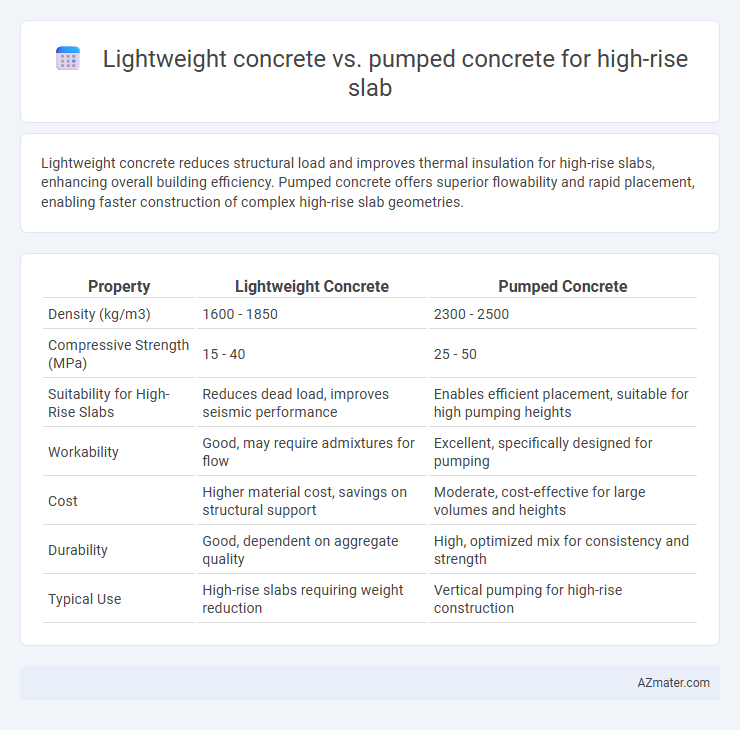Lightweight concrete reduces structural load and improves thermal insulation for high-rise slabs, enhancing overall building efficiency. Pumped concrete offers superior flowability and rapid placement, enabling faster construction of complex high-rise slab geometries.
Table of Comparison
| Property | Lightweight Concrete | Pumped Concrete |
|---|---|---|
| Density (kg/m3) | 1600 - 1850 | 2300 - 2500 |
| Compressive Strength (MPa) | 15 - 40 | 25 - 50 |
| Suitability for High-Rise Slabs | Reduces dead load, improves seismic performance | Enables efficient placement, suitable for high pumping heights |
| Workability | Good, may require admixtures for flow | Excellent, specifically designed for pumping |
| Cost | Higher material cost, savings on structural support | Moderate, cost-effective for large volumes and heights |
| Durability | Good, dependent on aggregate quality | High, optimized mix for consistency and strength |
| Typical Use | High-rise slabs requiring weight reduction | Vertical pumping for high-rise construction |
Introduction to High-Rise Slab Construction
High-rise slab construction demands materials that balance strength, weight, and workability to ensure structural integrity and efficient load distribution. Lightweight concrete offers reduced dead load, enhancing seismic performance and allowing for longer spans with thinner slabs. Pumped concrete facilitates rapid placement and compaction in tall structures, maintaining consistency and minimizing labor, making it ideal for complex high-rise slab geometries.
Defining Lightweight Concrete
Lightweight concrete, characterized by its lower density and reduced weight compared to normal concrete, is ideal for high-rise slabs due to its enhanced structural efficiency and decreased load on foundations. This type of concrete typically uses lightweight aggregates such as expanded clay, shale, or slate to reduce overall mass while maintaining adequate strength and durability. In contrast, pumped concrete refers to the method of placement, allowing conventional or lightweight mixes to be efficiently transported to high elevations, improving construction speed and consistency.
Understanding Pumped Concrete
Pumped concrete is specifically designed to maintain workability and avoid segregation during vertical transportation to high-rise slabs, ensuring consistent strength and durability. Unlike lightweight concrete, which reduces dead load by incorporating lightweight aggregates, pumped concrete emphasizes rheology, allowing it to be efficiently delivered through long-distance conveyors and vertical pumps. Optimizing mix design with suitable admixtures enhances pumpability and ensures uniform placement in complex high-rise slab forms.
Key Material Properties Comparison
Lightweight concrete for high-rise slabs offers reduced density, typically ranging from 1600 to 1920 kg/m3, significantly lowering structural dead loads compared to pumped concrete with densities around 2300 kg/m3. The thermal insulation properties of lightweight concrete improve energy efficiency, while pumped concrete provides superior workability and higher compressive strength, often exceeding 40 MPa, essential for high-load applications. Porosity and drying shrinkage are higher in lightweight concrete, requiring careful mix design and curing to mitigate crack risks in high-rise slab construction.
Structural Performance for High-Rise Slabs
Lightweight concrete offers reduced dead load, enhancing structural efficiency and seismic performance in high-rise slabs, while maintaining adequate strength and durability. Pumped concrete ensures consistent placement and compaction in complex slab geometries, improving uniformity and reducing voids, which contributes to improved overall structural integrity. Both materials impact load-bearing capacity and deflection control, with lightweight concrete benefiting in load reduction and pumped concrete excelling in construction quality and speed.
Workability and Placement Techniques
Lightweight concrete offers improved workability in high-rise slab applications due to its reduced density and enhanced flow characteristics, allowing easier handling and faster placement compared to traditional pumped concrete. Pumped concrete benefits from advanced placement techniques such as high-pressure pumping systems that enable efficient delivery to elevated slabs, though it may require admixtures to maintain workability and prevent segregation during pumping. Optimizing the mix design for both lightweight and pumped concrete is essential to achieve smooth placement and uniform compaction in complex high-rise slab structures.
Cost Implications and Economic Factors
Lightweight concrete reduces dead load, lowering structural costs by decreasing foundation and reinforcement requirements, making it economically beneficial for high-rise slabs. Pumped concrete offers faster placement and reduced labor costs, enhancing schedule efficiency but may incur higher material and pumping expenses. Evaluating total project costs, including material prices, labor, equipment, and time savings, determines the optimal choice between lightweight and pumped concrete for economic feasibility.
Durability and Long-Term Maintenance
Lightweight concrete offers enhanced durability for high-rise slabs by reducing structural load and minimizing cracking due to thermal expansion, making it ideal for long-term maintenance savings. Pumped concrete ensures consistent compaction and high density, improving resistance to wear, corrosion, and environmental stressors essential for durable high-rise construction. Choosing between the two depends on balancing structural weight concerns with maintenance cycles influenced by exposure and load demands.
Environmental Impact and Sustainability
Lightweight concrete significantly reduces the overall building weight, leading to decreased material consumption and lower carbon emissions during transportation and construction, enhancing sustainability for high-rise slabs. Pumped concrete typically requires more energy-intensive mixing and pumping processes, contributing to higher environmental impacts despite its efficiency in placement. Selecting lightweight concrete aligns better with green building standards by minimizing embodied energy and promoting resource efficiency in tall structure applications.
Best Practices for Selecting Concrete Type
Lightweight concrete offers reduced dead load and improved thermal insulation, making it ideal for high-rise slab applications where structural efficiency and energy savings are critical. Pumped concrete ensures high workability and consistent placement in tall structures, facilitating faster construction with superior density and strength. Selecting the best concrete involves assessing load requirements, pumpability, setting times, and cost implications to optimize performance and durability for high-rise slabs.

Infographic: Lightweight concrete vs Pumped concrete for High-rise slab
 azmater.com
azmater.com